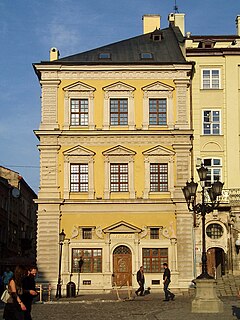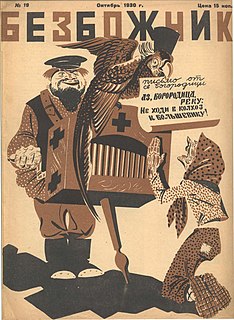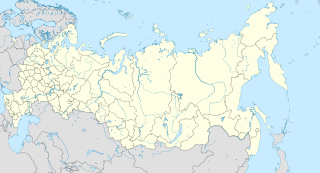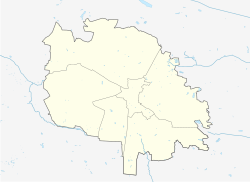Kalmyk Oirat, commonly known as the Kalmyk language, is a register of the Oirat language, natively spoken by the Kalmyk people of Kalmykia, a federal subject of Russia. In Russia, it is the standard form of the Oirat language, which belongs to the Mongolic language family. The Kalmyk people of the northwest Caspian Sea of Russia claim descent from the Oirats from Eurasia, who have also historically settled in Mongolia and northwest China. According to UNESCO, the language is "Definitely endangered". According to the Russian census of 2010, there are 80,500 speakers of an ethnic population consisting of 183,000 people.

Ivan Fyodorov was one of the fathers of Eastern Slavonic printing, he was the first known Russian printer in Muscovy and the Polish-Lithuanian Commonwealth, he was also a skilled cannon maker and the inventor of a multibarreled mortar.

The Directorate, or Directory was a provisional collegiate revolutionary state committee of the Ukrainian People's Republic, initially formed on November 13–14, 1918 during a session of the Ukrainian National Union in rebellion against Skoropadsky's regime. During the overthrow of Pavlo Skoropadsky it was named as the Executive Council of the State Affairs. Its authority was extended by the Labor Congress of Ukraine on January 23–28, 1919.

Alexander Svirsky or Alexander of Svir (1448–1533) was an Eastern Orthodox saint, monk and hegumen of Russian Orthodox Church.

Principality of Halych, or Principality of Halychian Rus', was a medieval East Slavic principality, and one of main regional states within the political scope of Kievan Rus', established by members of the oldest line of Yaroslav the Wise descendants. A characteristic feature of Halych principality was an important role of the nobility and citizens in political life, consideration a will of which was the main condition for the princely rule. Halych as the capital mentioned in around 1124 as a seat of Ivan Vasylkovych the grandson of Rostislav of Tmutarakan. According to Mykhailo Hrushevsky the realm of Halych was passed to Rostyslav upon the death of his father Vladimir Yaroslavich, but he was banished out of it later by his uncle to Tmutarakan. The realm was then passed to Yaropolk Izyaslavich who was a son of the ruling Grand Prince of Kiev Izyaslav I of Kiev.

The Carmelite Convent was established in Lviv by Jakub Sobieski. Many particulars of its design were patterned after the Roman church of Santa Susanna. Its construction, commenced in 1642, was greatly delayed by the events of the Deluge. The Carmelites departed from the nunnery in 1792. It was later used as a metrology office. The Ukrainian Greek Catholic Church recently reconsecrated the church to Christian worship and dedicated it to the Presentation of Our Lord.

Hlyniany Gate is the focal point of the few remaining fortifications in Lviv, Ukraine. It was built in 1618 to Fryderyk Getkant's designs in order to defend the approach from Hlyniany. The outer moat and the wooden galleries on the inside are the upshot of a 1970s reconstruction. Just beyond the gate is the Bernardine monastery.

Bandinelli Palace is a late Renaissance townhouse (kamienica) facing Market Square in Lviv, Ukraine. It was built in 1589 by a pharmacist Jarosz Wedelski, and in 1634 it was bought by a Florentine merchant, Roberto Bandinelli, known as the founder of the first post office in eastern Galicia. That office was housed in the building from 1629 onward, and was closed in a few years when the business became unprofitable.

The Lviv palace of Prince Stanisław Lubomirski was built in the 1760s to Jan de Witte's design on the site of several older houses. The palace's main façade, featuring decoration by Sebastian Vessinger, is on the Market Square. The two other fronts are considerably less conspicuous.

The Korniakt Palace on Market Square in Lviv is a prime example of the royal kamienica, or townhouse. The fabric of the palace is of various dates. It was originally built by Polish architect Piotr Barbon for merchant Konstanty Korniakt, a champion of Greek Orthodoxy and co-founder of the Lviv Dormition Brotherhood. Construction of this severely elegant Renaissance palazzo was completed in 1580.

Saints Peter and Paul Garrison Church (1610-1630) is known to Lviv's residents as the Jesuit Church and was built in the style of early baroque in the beginning of the 17th century. The building resembles Rome's Il Gesù Cathedral and is considered one of the most beautiful religious buildings in Lviv. The church was reopened on December 6, 2011 to celebrate the 20th anniversary of the Armed Forces of Ukraine. The rite of consecration of the church building and the celebration of the first Divine Liturgy was done by Archbishop and Metropolitan of Lviv of UGCC bishop Ihor Voznyak.

Tukholka is a village (selo) in Skole Raion, Lviv Oblast, in western Ukraine. The village Tukholka is located in the Ukrainian Carpathians within the limits of the Eastern Beskids in southern Lviv Oblast in Skole Raion. Remotely from Lviv on 131 km, from Skole - 28 km and from Uzhhorod – 131 km. The village is located in the river valley Brynivka. Local government — Tukholkivska village council.

The idea of the preservation of kobzar music by means of sound recording originated in 1901–02. Kobzars were itinerant Ukrainian folk musicians who sung dumas and folk songs to their own accompaniment of kobza, bandura or lira.

Bezbozhnik was an illustrated magazine, an organ of the Centre Soviet and Moscow Oblast Soviet of the League of the Militant Godless.
Humnyska is a village (selo) in Busk Raion, Lviv Oblast of Western Ukraine.
The village covers an area of 2,389 km2 at an altitude of 218 metres (720 ft) above sea level. Local government is administered by Humnyska village council. A village Chuchmany is also in the structure of local government.

Ivan Ivanovich Levynskyi was a Ukrainian architect, teacher, businessman and public figure.

Khotiv hillfort is a hillfort of early Iron Age in the village of Khotiv, Ukraine.

Tustan was a Medieval cliff-side fortress-city and customs site of the 9th—16th centuries, an Old Rus cliff-side defensive complex. Its remains are located in the Ukrainian Carpathians, in the Skole district of the Lviv oblast, near the village of Urych, southwards from the town of Boryslav and to the southern-east from the village of Skhidnytsia. The unique monument of history, archeology, architecture, and nature is situated amidst the woods of Pidhorodtsi Forestry and is part of the Tustan Site Museum.

Odoyev is an urban settlement since 1959, in the west of Tula Oblast, Russia, the administrative center of Odoyevsky District. It sits on the left bank of the Upa river, a right-hand tributary of the Oka river, 75 km away from Tula. Odoyev had the status of town prior to 1926.

Konstantin Ivanovich Makarov was a Soviet revolutionary and Putilov worker, member of the RSDLP since 1917.





















